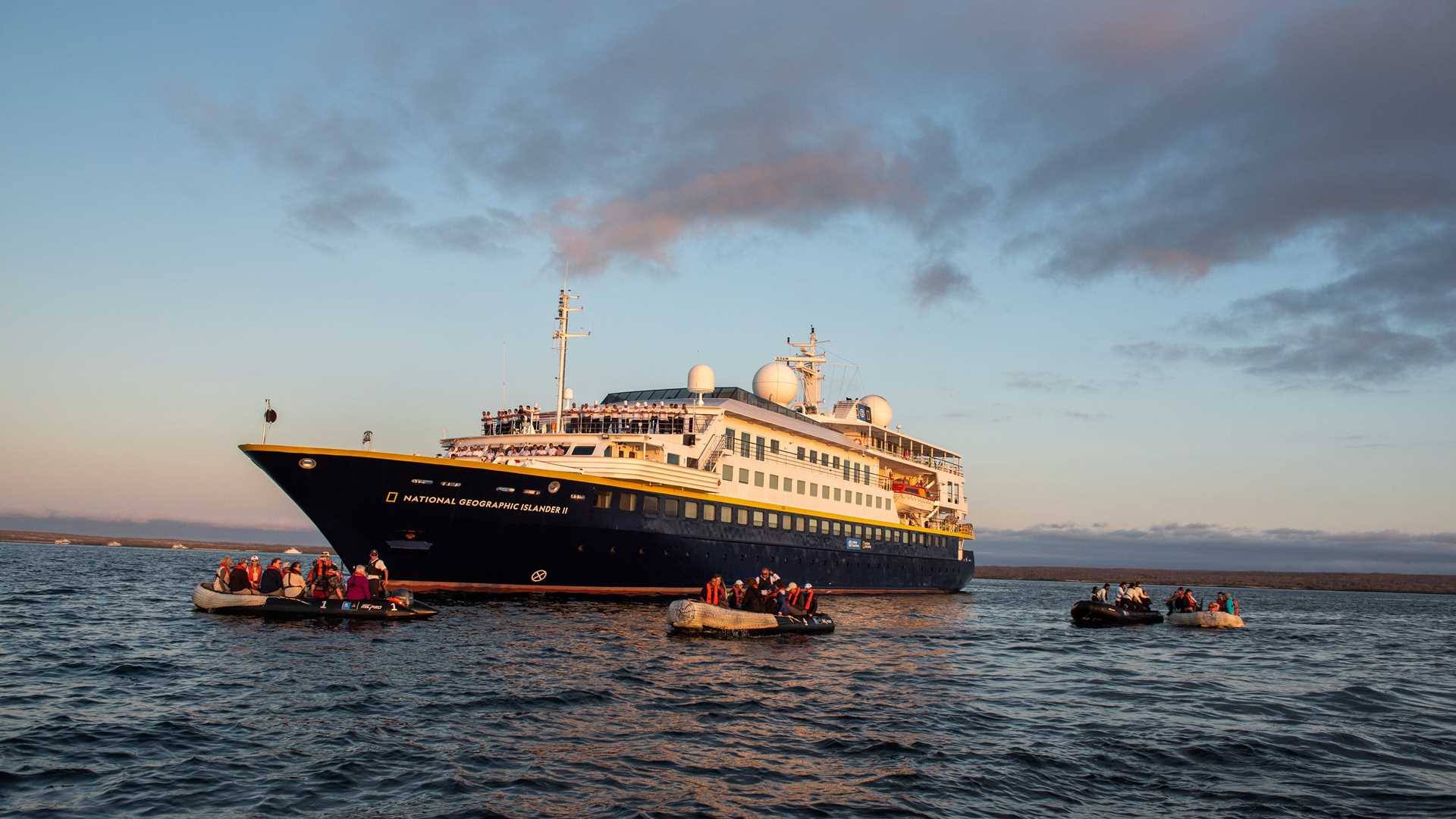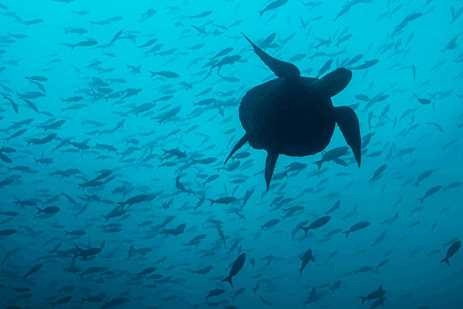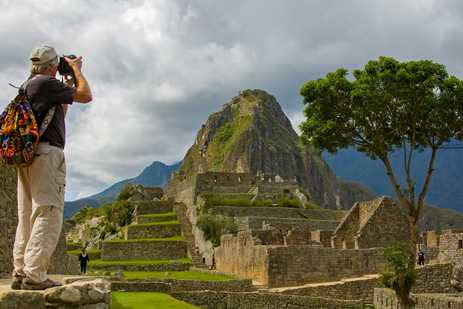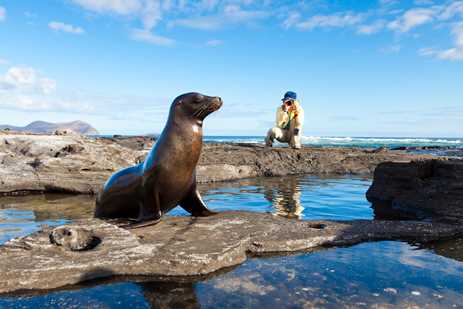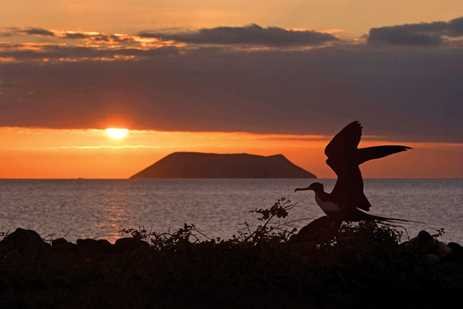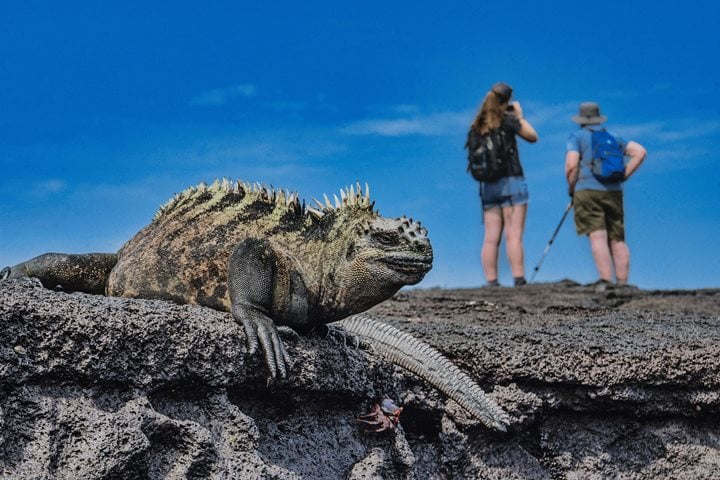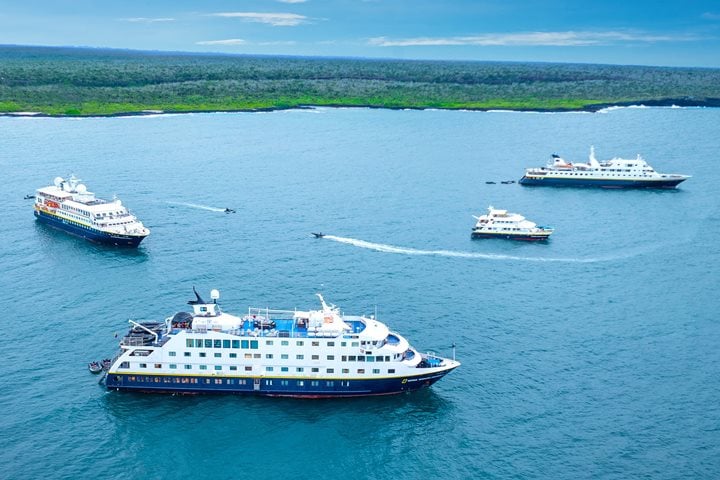Call +1.800.397.3348 or contact your travel advisor
For nature lovers and adventure seekers alike, the call of the legendary Galápagos is incredibly hard to resist. However, the cost to go to Galápagos Islands is an investment, whether you’re hoping to book your dream cruise or plan a DIY land tour.
To help you make the most of your budget—whatever it may be—this essential guide draws on Lindblad Expeditions’ 50-plus years of experience sharing the archipelago’s ecological wonders and endemic species.
How Much Does it Cost to go to Galápagos Islands?
The cost of traveling to the Galápagos Islands varies based on a number of factors, but the average price for a weeklong trip runs around $8,000-$10,000. Don’t let those numbers get in the way of learning more, but this sort of trip is called “once-in-a-lifetime” for a reason. Even the most basic budget trips to Galápagos can cost upwards of $2,000-$3,000 in total.
Due to the archipelago’s remote location (more than 600 miles from the coast of Ecuador), it’s expensive to live and do business in the islands, which are dependent on tourism. Food and other essential items often need to be imported from the mainland, so costs reflect this.
Furthermore, as one of the world’s preeminent ecotourism destinations, the National Park and Marine Reserve must operate with costs that ensure both fair wages and conditions for local workers and for conservation of the natural treasures found in this UNESCO World Heritage Site.
You can rest assured knowing your vacation budget is a key contributor to the preservation of the breathtaking beauty of the Galápagos islands and the creatures who call them home.
Average Cost of Galápagos Trip
On average, visitors should budget $500-$1,000 per day spent in Galápagos. This estimate takes accommodations, meals, transportation, and tours into account. It’s certainly possible to spend less (or much more), but these numbers can serve as a broad guideline for the early stages of mapping out your trip.
Things to Consider When Pricing a Galápagos Vacation
Before you can determine how much it costs to travel to Galápagos islands, you’ll need to decide whether you’d prefer to be based on land or to travel aboard an expedition cruise ship.
Land tours are the more affordable option across the board. However, they come with a lot of limitations so they may not be worth the savings depending on what you’re hoping to get out of your trip. In the next section, learn more about the difference and everything else you need to consider when creating a broad-strokes budget.
Cost to Fly to Galápagos
From the U.S., you can expect to spend between $1,000-$1,200 on flights that will get you to the Galápagos.
First, you’ll need to fly to Quito or Guayaquil, Ecuador which are both gateways to the Galápagos. Fares from major cities like Miami and New York average around $500-$550 for an economy-class plane ticket.
From there, a round-trip flight to either San Cristóbal or Baltra, just off Santa Cruz Island, ranges from $360-$500. Most flights out to the archipelago are scheduled early in the day, so you may also need to stay overnight on the mainland where hotels average $85-$100 a night.
On arrival at the airport in Galápagos, each traveler is charged a $200 National Park Entrance Fee ($50 for children under the age of 12) and must purchase a $20 Transit Control Card at the airport in Quito or Guayaquil. These must be paid in cash. If you’re traveling on an expedition, representatives from your cruise company will often help take care of these payments on your behalf.
Traveling on a Galápagos Cruise vs. Land Tour
Of the 20 Galápagos islands open to tourism, each has its distinct highlights. However, the magic of Galápagos lies in the vast degree of variation in landscapes and microclimates of the archipelago at large. From the rust-red cliffs of Rábida to the peridot-sprinkled sand of Floreana—the more you see, the more you’re able to comprehend what makes these “Enchanted Islands” so extraordinarily special.
Galápagos cruises are, without a doubt, the best way to see more islands. Most ships navigate while you sleep at night, so that not a minute of your time is wasted getting from point A to B. You also won’t need to juggle all the logistics of ferry schedules, hotel check-in policies, restaurant hours, site regulations, and day tour offerings.
For those with a tight budget who don’t mind handling these and other detailis involved in DIY trips, land-based stays are a feasible option. There are hotels and accommodations available on four islands: San Cristóbal, Santa Cruz, Isabela, and Floreana—though the latter two have more limited options.
Keep in mind, Galápagos is not your typical vacation destination. 97 percent of the terrain is protected by the National Park, so you must hire a licensed guide to access the visitor sites where all the action is. When they’re not included with a ship’s itinerary, Galápagos islands tours cost between $60-$250 per day, depending on the length and scope.
If you’re choosing a land-based trip, it’s reasonable to expect to see three to four islands, and you will likely need at least a week to do so. Also, you will be limited to the uninhabited islands that can be reached via day tour.
Quality of Accommodations and Tour Operators (Luxury vs. Budget Options)
With both cruise ships and land tours, costs tend to reflect the level of privacy and access they afford. If you don’t mind sharing bathrooms, kitchens, and living spaces with other guests, it’s possible to find more affordable accommodations.
In Galápagos, some hostels offer beds for as low as $30 per night and quality hotels start around $100 per night. Budget cruises can be booked for as little as $2,000-$3,000, but these tend to provide little more than spare sleeping quarters and transportation between visitor sites.
On the other hand, luxury cruises can cost as much as $20,000 or more. Cruise pricing mainly comes down to the length of the trip, quality of service, and guest capacity—which can range from 12-100 passengers depending on the travel operator.
For example, on a small luxury cruise, cozy, well-appointed suites are standard, and higher costs might come with perks like plunge pools, balconies, or butler service. Of course, these elevated extras will increase the overall price, but depending on your personal taste and budget, you might consider them worth it in order to enhance your experience.
Expedition cruises, like those offered by Lindblad Expeditions-National Geographic, also range on the higher scale with prices reaching upwards of $18,000 depending on the itinerary and cabin category. These vessels are designed to navigate to the most remote landing sites and are staffed with expert naturalists and specialists to curate the best Galápagos experience possible. Itineraries focus on maximizing water and land excursions and padding the in-between with all the creature comforts you need to recuperate between days of adrenaline-spiking adventure.
Food and Drinks
On a cruise, meals are typically included in the overall cost, though alcohol may not be. Eating onboard also doesn’t mean you’ll have to miss out on the local cuisine, as many ships source and prepare traditional Ecuadorian food in addition to a variety of American favorites.
One priceless point to consider is that those with food allergies or sensitivities will rest easy knowing the professional chef and kitchen staff onboard an expedition ship will be well-equipped to accommodate their needs.
On land in Galápagos, meal costs average about $20-40 per day. Ecuadorian fare will be the most readily available and wallet-friendly option, though there will also be pricier options for more international fare. Make sure to pay attention when booking hotels and tours as many accommodations offer breakfast and day trips often include lunch.
Length of Your Galápagos Trip
How much time you spend in the Galápagos is a major factor in the trip’s overall cost. Charles Darwin himself only spent five weeks there and had enough inspiration to write On the Origin of Species, his seminal work on the theory of evolution.
This guide on How Much Time to Visit the Galápagos will help you decide.
Example Galápagos Itinerary Cost
On a cruise, you won’t need to plan out which Galápagos islands to go to ahead of time. Due to regulations that help lessen the impact of tourism, visitor sites are subject to strict rotation, so ships operate on set schedules. No matter which itinerary you join, you'll see a diversity of unique wildlife and landscapes.
How Many Days Should I Spend in Galápagos?
Four days is the absolute minimum you should spend in Galápagos, not only because of the time it takes to travel to and from this remote archipelago, but also because there’s such an incredible diversity of life that we can all but guarantee you’ll leave wanting to experience much more.
Here are some sample itineraries with average costs for trips of varying lengths on both land and at sea.
4-day Trip to Galápagos Island Cost
A week is the ideal amount of time to spend in Galápagos, and cruises of this length cost $1,500-$2,000 per person, in addition to airfare.
You’ll be able to experience the wonders of seven or more islands and islets and the profound riches of the surrounding seas. Here’s what the week’s schedule might look like for an 8-day expedition cruise.
Day 1: Santa Cruz
- Head to the highlands to encounter giant tortoises in their natural habitat.
Day 2: North Seymour and Rábida
- Explore two islands rich in birdlife like frigates and blue-footed boobies.
Day 3: Isabela and Fernandina
- Swim amongst Galápagos penguins, playful sea lions, and marine iguanas.
Day 4: Santiago
- Spend time exploring tide pools and spotting flashes of vibrant red Sally Lightfoot crabs.
Day 5: Bartolomé
- Marvel at volcanic geology from a stunning viewpoint and get up close to colorful Galápagos land iguanas.
Day 6: Floreana
- Spot flamingoes in a pink-tinted lagoon and drop-off a postcard (or pick one up to hand-deliver) at the historic barrel at Post Office Bay.
Day 7: Española
- Seasonally, see the world’s only population of waved albatross.
Day 8: San Cristóbal
- Hike this gorgeous island home to all three types of boobies: Nazca, blue-footed, and red-footed.
More: Wild Galápagos Escape - Expedition Cruises
10-day Trip to Galápagos Island Cost:
If you have 10 days to spend, expect to pay on average between $8,000-$12,000 per person. For a more affordable trip of this length, here’s an example of a land-based itinerary, which might end up costing as little as $4,000-$5,500 but you will need to invest a lot more time to plan.
Days 1-4: San Cristóbal
- Check out the visitor sites at Punta Pitt, Kicker Rock, Sea Lion Rookery, and Cerro Brujo—one of the first places Charles Darwin visited.
- Book an Española day tour to see the waved albatross and snorkel the turquoise waters of Gardner Bay.
Days 5-10: Santa Cruz
- Popular visitor sites include Cerro Dragón (Dragon Hill), Las Grietas (The Crevices) and El Mirador, and the Highlands & Tortoise Reserve.
- Book day tours of Bartolomé, South Plaza, North Seymour, or Santa Fe—where you can see the largest cactus trees in Galápagos, Santa Fe land iguanas, and Galápagos hawks.
More: Galápagos aboard National Geographic Endeavour II | Expedition Cruises
12-day Trip to Galápagos Island Cost
This incredible, nearly two-week-long adventure averages $12,000-$15,000 per person. It will likely include 10 or more islands and islets, stretching to the farthest reaches of pristine Galápagos wilderness. Here is an example of a 12-day cruise itinerary.
Day 1: Santa Cruz
- Explore the shore of Bachas Beach where sea turtles nest and flamingos feed at nearby ponds.
Day 2: Chinese Hat & Santiago
- Kayak the grottos of Buccaneer’s Cove and soak up the sun near piles of cuddling fur seals at Puerto Egas.
Day 3-4: Isabela
- Wander volcanic landscapes in search of Darwin’s finches perched atop the fascinating endemic flora.
Day 5: Fernandina
- Enter flightless cormorant territory, also home to largest marine iguana population.
Day 6: Bartolomé
- Photograph penguins and candelabra cacti on the same lava rock landing.
Day 7: South Plaza & North Seymour
- Enjoy the antics of sea lion pups amidst a riot of colorful, salt-loving succulents.
Day 8: San Cristóbal
- Spot endemic lava lizards and mockingbirds and enjoy one of the world’s most beautiful beaches.
Day 9: Española
- Observe seabirds at every stage of life: eggs, chicks, juveniles, and elegant, soaring adults.
Day 10: Floreana
- Snorkel at Champion Islet with colorful fish, dozens of sharks, sea lions, and sea turtles.
Day 11: Santa Cruz
- Pay your respects to Lonesome George and meet giant tortoises at the Charles Darwin Research Center.
Day 12: Genovesa
- Paddle along the cliffs of this flooded caldera, or head inland to search for the endemic short-eared owl.
More: Ultimate Galápagos Holiday Voyage | Lindblad Expeditions
What is Worth Spending Money on During Your Galápagos Cruise?
This is a once-in-a-lifetime trip in a once-in-a-lifetime destination. To get the most out of it, you’ll want to prioritize expert experience with an expedition team made up of Galapagueños who were raised in the islands. The crew’s knowledge of and relationships with the local ecosystem can make or break your trip—not only from a safety standpoint, but also when it comes to making decisions about what the most rewarding experience to pursue at any given point of the journey will be. A passionate crew you can trust with deep knowledge of the islands is priceless.
It’s also worth choosing a company with multiple guides which allows for smaller groups ashore and more freedom to choose your flavor or level of excursion. On cruises without pre-assigned groups, you can gravitate toward the naturalists who share your interests, whether that’s photography or birding, and you’ll often be given daily activity options so you can choose between a vigorous volcano hike or a leisurely beach walk.
Lastly, to make sure you’ll be well equipped to explore the wildlife-rich marine reserve, look out for a list of all-inclusive tools like Zodiacs, kayaks, stand-up paddleboards, and snorkeling and diving gear
Ways to Save Money on Your Galápagos Cruise
Unlike many other destinations, Galápagos doesn’t technically have an off-season thanks to its proximity to the equator. Anytime is good time to visit the Galápagos since there is always something happening with the wildlife. However, the most in-demand travel dates tend to occur when children are on break from school from June through August or during the winter holidays, so it may help to book outside of that season.
If your travel dates are flexible, set aside your budget and stay alert for last-minute deals. Some cruise companies will also offer promotions like included roundtrip airfare or an airfare credit when you book. It’s best to sign up for their mailing lists and follow their social media accounts so you don’t miss out on any special discounts.
Common Galápagos Island Trip Questions
Why are Galápagos Cruises so Expensive?
Expedition ships are designed to travel to the world’s most remote places, and this access comes at a high cost to maintain, insure, and operate with the utmost safety standards. On a smaller ship, there are also less passengers to offset the costs of hiring a top-tier crew—from the veteran navigation team to the kitchen staff to local naturalist guides with a personal connection to the region’s culture and history. Some cruise lines also give back to the local ocean and wildlife conservation efforts.
Is a Galápagos Cruise Worth the Money?
There are absolutely destinations where a cruise is a comparable experience to staying on land; however, Galápagos is not one of them. While each island has its own distinct highlights, the true Galápagos experience is getting to know the astonishing array of diversity and geography throughout the archipelago.
Traveling on a cruise is not only the most efficient way to do this, but also the most enjoyable. So, what you spend in money makes up for savings in time and stress, both during planning and on the trip itself.
Additionally, onboard a ship, you'll have much easier access to the rich waters surrounding the islands and the marine life that inhabits them. Some expedition cruises stock all the gear guests might want to explore, from snorkel masks and flippers to stand-up paddleboards and kayaks; and Lindblad Expeditions-National Geographic is one of few ships that also offer a glass-bottom boat for those who’d love to see the underwater wonders but prefer to stay dry.
Can you Visit the Galápagos on Your Own?
Yes, traveling to the Galápagos Islands without a tour group or cruise is certainly possible, but it requires substantial planning and preparation. Tourists are only permitted to explore 60 approved and regulated visitor sites throughout the islands, and most have a marked trail. However, it is a rule of the National Park that travelers must always be accompanied by a licensed Galápagos National Park guide.
We’ll be the first to admit that it’s hard to put a price on just how reinvigorating a place as wild as Galápagos can be. The impact of this incredible place and its creatures will last long beyond your final day on the itinerary—whether you’re inspired to sketch out the beginnings of a scientific breakthrough or to bring a bit more of the wild spirit of our amazing planet back with you into everyday life.

